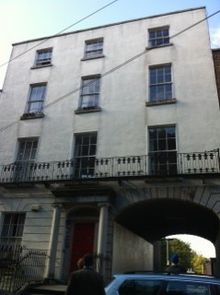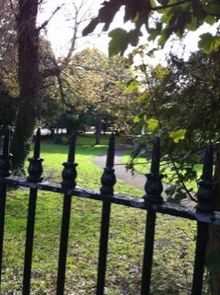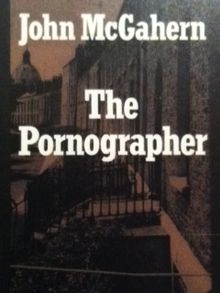- Mount Pleasant Square
-
Mount Pleasant Square is a Georgian style residential development on the border of Rathmines and Ranelagh, in the city of Dublin, Ireland. It is about fifteen minutes’ walk from Grafton Street.
Completed in 1834, the square is widely celebrated for its elegance and quiet charm. In her article in The Georgian Squares of Dublin, Susan Roundtree writes: "It has justifiably been described as one of the most beautiful early 19th-century squares in Dublin."[1] In the March 24, 1978 edition of In Dublin magazine, Gordon Lynch wrote, "The recently face-lifted Mount Pleasant Square, which is protected by a preservation order, is the only curved square in Dublin, if such a thing is possible."[2]
There are 56 terraced houses on three sides of a central open space, now housing a tennis club and a small public park. The north and south sides are crescents rather than typical borders of a square. About half of the houses are occupied by young families, while several remain in apartments. Homes on the west side have south-west facing back gardens, there is a Victorian era post-box on the south-west corner of the square,[3] and 24-hour disc parking is enforced with sadistic pleasure.[4]
Contents
History
Mount Pleasant Square is about 100 yards from where the Ranelagh Gardens once stood. The public park beside the LUAS station is all that remains of what were once far more extensive grounds. Richard Crosbie became the first Irish person to fly a balloon when he took off from the gardens in 1785. Crosbie wanted to cross the Irish Sea, but only made it to Clontarf. After the Act of Union in 1801, middle-class professionals abandoned Georgian mansions on the northside, and moved to places with smaller, more manageable houses in new southside suburbs such as Rathmines and Ranelagh. As Susan Roundtree notes: “The first suburban boom accelerated during subsequent generations and established the pattern of city centre migration to the suburbs.”[1]
Mount Pleasant Square was developed in the early 19th century, much of it by the Dolan family. Terence Dolan was a glove maker from Chester who bought plots of land from a Solomon Williams (also of Chester) in three transactions: in 1807, 1808 and 1812.
On the first plot of land – on the south side of what is now the square – Dolan built eight houses (Nos 36–43). At the time, these houses would have had commanding views of the city centre. A speculative developer, Dolan leased out the properties on short leases and raised the money to build more houses. By 1812 he had acquired all the land on the north and west sides of the square.
The second son of Terence Dolan, Terence Thomas Dolan, was a key mover behind the Rathmines Township, and was one of its first commissioners in 1847. By 1848 he effectively owned 32 of the houses on the square. His son, Henry Joseph Dolan, became President of Mount Pleasant Lawn Tennis Club in the centre of the square, when it was established in 1893.
The social composition of the houses has always been varied. In the past, many doctors and solicitors lived on the square, which is relatively close to Fitzwilliam Square and the Law Library. The square once housed two schools, and in 1911 the 14 inhabitants of No 27 included a carpenter, a scholar and a fishmonger.[5][6] Of the 387 people who lived on the square that year, there were 149 Catholics, 177 Church of Ireland, 20 Presbyterian, 10 Methodist and 7 Baptists. An average of 7 people lived in each house.[7]
Architecture
Most of the houses are two-storey over basements that are below ground level. Many of the gardens have now been shortened to accommodate mews buildings. There is a lot of variation in individual house construction, as the plot sizes are not uniform.
Susan Roundtree notes that the houses were probably built by tradesmen rather than skilled craftsmen. Three bay houses were soon joined by smaller, two-bay houses that were effectively miniature versions of the city houses with two principal rooms on each floor. The basement walls are about two feet thick, with limestone calp used throughout. The windows were typical vertically sliding timber sashes.[1]
Mount Pleasant Square is an example of rus in urbe, ‘a countryside in the city’.[1] The overall composition is more impressive than any one house. With its bucolic curtain of trees and handsome terraced Georgian houses, the atmosphere on this well-preserved square is often described as Dickensianas if residents step into a period drama every time they leave the house. There is something elegant, if slightly bashful, about the whole effect: drooping trees, little traffic, gentle plop of tennis balls (followed by mild profanity).
Public park
The small public park beside the tennis club is unsatisfactory. It was the subject of a planning controversy in the 1970s.[1] At one point it seemed inevitable that the thin sliver of land would be given over to a garage, but a well-orchestrated outcry ensured its survival as a public amenity. At the moment its principal occupants are two drug dealers. They lend the park an air of menace, and cost almost nothing to maintain.
Local amenities
Mount Pleasant Lawn Tennis Club has squash, badminton and tennis courts, as well as a table tennis table, a snooker table and a bar.
The Hill Pub occupies a prominent position at the south-east corner of Mount Pleasant Square. It is best described as a handsome pub from the outside.
A Pakistani gentleman called Ahmed runs a shop beside the pub on Mount Pleasant Avenue, accessible through the arch on the western side of Mount Pleasant Square. He is renowned in the area as a warm and friendly man who is particularly kind to children and older people.
Ranelagh boasts a shell-shocked array of discount stores for the newly poor, as well as several expensive cafés and far too many restaurants. The two places that locals recommend with any frequency are Dillingers and Eatery 120. Rathmines has only Jo’Burger to boast about on the restaurant front, but it also has a soul.
Rathmines is where you will find the local library, swimming pool, health-food store, cinema and exotic people of many nationalities. If you wanted to bring a visitor to see the real Dublin, you would avoid Ranelagh. It’s where the people organizing the local arts festival fell out with each other, and even though it has more restaurants than any other suburb in the city, there weren’t enough foodies to support a farmers’ market.
Mount Pleasant LTC
The square is home to one of Dublin’s leading racquet sports clubs, and the only club in the city with tennis, squash and badminton sections (and table tennis too). Mount Pleasant L.T.C. was founded in 1893, making it amongst the oldest clubs in Dublin.
The club holds a variety of tournaments, including tennis Open Week, one of the largest tournaments in Ireland. Mount Pleasant is among the premier badminton clubs in Leinster. Membership stands at around 1,000 with about 700 tennis members and the rest more or less equally divided between squash and badminton.
A small timberland to the west of the courts is known locally as Benjamin’s Forest, after a local man called Benjamin Walter Martin who once juggled six live chickens.[8]
Mount Pleasant Square in literature
The cover of John McGahern’s novel, The Pornographer, features the curved north terrace of Mount Pleasant Square.
References
- ^ a b c d e Susan Roundtree, "Mount Pleasant Square," The Georgian Squares of Dublin: An Architectural History, Dublin City Council, 2006
- ^ Gordon Lynch, (article in) 'In Dublin', 24 March, 1978
- ^ O'Rourke, Aidan (2011-08-08). "Picture: Green-painted post box Mount Pleasant Square Ranelagh". http://www.aidan.co.uk/photo7668.htm.
- ^ Dublin City Council (2011-08-08). "SEA Agenda February 10". http://www.dublinonice.ie/YourCouncil/LocalAreaServices/SouthEastArea/Documents/SEAAgendaFebruary10.doc.
- ^ "1911 Census". 2011-08-08. http://www.census.nationalarchives.ie/pages/1911/Dublin/Rathmines___Rathgar_East/Mountpleasant_Square/50661/.
- ^ "1911 Census". 2011-08-08. http://www.census.nationalarchives.ie/pages/1911/Dublin/Rathmines___Rathgar_East/Mountpleasant_Square/50663/.
- ^ "1911 Census". 2011-08-08. http://www.census.nationalarchives.ie/pages/1911/Dublin/Rathmines___Rathgar_East/Mountpleasant_Square/.
- ^ Deirdre Kelly,Four Roads to Dublin: A History of Rathmines, Ranelagh and Leeson Street, O'Brien, 2001.
Susan Roundtree, The Georgian Squares of Dublin
Categories:- Squares in Dublin (city)
Wikimedia Foundation. 2010.






